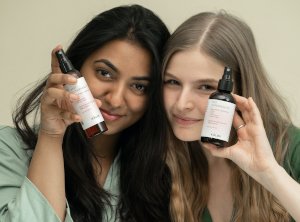 There are so many beauty products popping up, it can be hard to keep track. Not long ago we only had toners, but now there are also tonics. What is the difference between toners and tonics and is there any difference at all or maybe it’s just a marketing trick to make you buy more products? Let’s figure it out together.
There are so many beauty products popping up, it can be hard to keep track. Not long ago we only had toners, but now there are also tonics. What is the difference between toners and tonics and is there any difference at all or maybe it’s just a marketing trick to make you buy more products? Let’s figure it out together.
People who follow at least a basic skincare routine know what a face toner is and what it is used for. Skin toners are applied after cleansing; they remove any last impurities and facial cleanser residue, help to restore skin pH balance, and prepare your skin for further application of a moisturiser or serum. Depending on the skin type they are designed for, skin toners can be based on water, alcohol, or oils.
As for tonics, they have hit the shelves relatively recently, and many people don’t know what skin tonics are for or whether there is any difference between them and skin toners at all. Let’s take a closer look at face tonics: their purpose, active ingredients and skincare benefits.
Like many other innovative skincare products, face tonics originated in Asia, where they are also known as essences. Many Asian women have an elaborate skincare routine consisting of seven or even ten steps. In such beauty routines, a face tonic is usually applied before moisturising in order to reduce the loss of skin moisture caused by cleansing.
The famous 10-step Korean skincare regimen and Korean beauty products have become pretty popular in Europe and North America, so it is not surprising that skin tonics are becoming popular as well. However, a lot of people still confuse them with toners because the names are so similar; they can’t decide whether they need to use both products or just one of them.
It’s actually pretty simple. Both toners and tonics are used after washing your face. Both products can prepare the skin for the next steps of your beauty regimen, but they have slightly different purposes, textures, and active ingredients.
Skin toners are usually liquid. Their main purpose is to remove impurities and facial cleanser residue from the skin and normalise its pH balance. Most toners usually contain refreshing, rejuvenating, and skin balancing ingredients. Toners for oily skin may also contain anti-inflammatory, soothing, and astringent ingredients.
Tonics can be liquid too, but they can also have a gel-like or creamy texture. They are formulated with moisturising ingredients with an instant effect. Skin tonics actively hydrate the skin, restore its healthy glow, improve complexion, and help to boost the effect of other skincare products in your beauty routine.
Modern beauty industry offers a huge selection of all kinds of cosmetics for different skin types and purposes. Due to this, it may be difficult to draw a hard line between toners and tonics: you can buy a moisturising face toner or a tonic that balances skin pH levels. If you want to avoid confusion and choose the product that’s best for you, don’t focus on the name. Instead, pay attention to the declared functions of the product and peruse its ingredient list.
For example, if your skin needs more hydration, check out toners and tonics formulated with hyaluronic acid, witch-hazel extract, aloe vera leaf juice, allantoin, glycerine, gotu kola extract, etc. If you need to balance the skin and normalise sebum secretion, look for toners and tonics that contain aloe extract, tea tree oil, AHAs or BHAs (alpha or beta hydroxy acids).
If you need a soothing product, try a toner or a tonic with green tea extract, chamomile extract or gotu kola extract. To boost skin elasticity, use products with peptides, antioxidants, and collagen. Finally, to even out skin tone and prevent pigmentation, buy a tonic or a toner with niacinamide, vitamin C, or bearberry extract.
